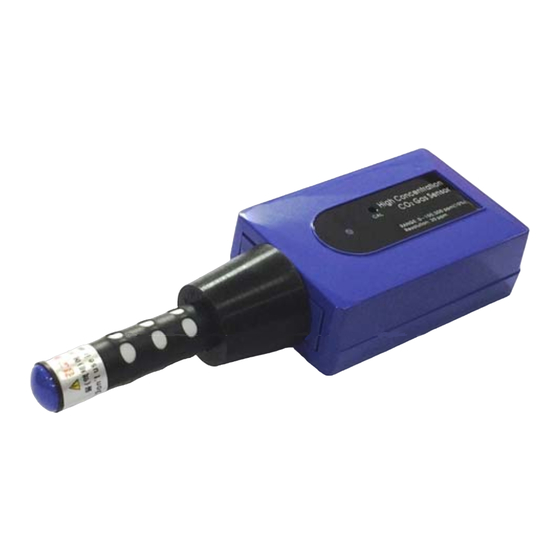
Advertisement
Description
The ScienceCube CO
2
biology and chemistry experiments. It measures in range of 0 to 10 volume % (100,000 ppm) by
recording the amount of infrared radiation absorbed by carbon dioxide molecules.
Important : The sensor tube can never be placed into any liquids. The sensor is
intended only for measuring gaseous, not aqueous, CO
The sensor uses a hot metal filament as an infrared source (IR), which is located at one end of the
sensor tube. At the other end of the sensor tube is an infrared sensor that measures how much
radiation gets through the sample without being absorbed by the carbon dioxide molecules. The
detector measures infrared radiation absorbed in the narrow band centered at 4.26㎛. The greater
concentration of the absorbing gas in the sampling tube, the less radiation will make it from the source
through the sensor tube to the IR detector.
The temperature increase in the infrared sensor produces a voltage that is amplified and read by an
interface.
CO
gas moves in and out of the sensor tube by diffusion through the six vent holes in the sensor
2
tube. When the sensor is collecting data, the IR source blinking on and off – it takes a new reading
about once every 3 second.
Suggested experiments
Measuring CO
Monitoring CO
light/dark (combination with the light sensor).
Measuring CO
Monitoring production of CO
+ HCl CO
Na
CO
2
3
Monitoring CO2 consumption during chemical reactions:
2NaOH + CO
2
High Concentration
CO
Gas Sensor
2
Figure 1. High Concentration CO
gas sensor is used to monitor gas concentration carbon dioxide in variety of
levels (respiration) from small animals and insects.
2
changes in a plant terrarium during photorespiration and photosynthesis in
2
levels during cellular respiration of peas or beans.
2
during chemical reactions
2
+ H
O + NaCl
2
2
Na
CO
+ H
O
2
3
2
Gas Sesor
2
concentration.
2
- 1 -
KDS-1037
Advertisement
Table of Contents

Summary of Contents for ScienceCube KDS-1037
- Page 1 Figure 1. High Concentration CO Gas Sesor Description The ScienceCube CO gas sensor is used to monitor gas concentration carbon dioxide in variety of biology and chemistry experiments. It measures in range of 0 to 10 volume % (100,000 ppm) by recording the amount of infrared radiation absorbed by carbon dioxide molecules.
- Page 2 KDS-1037 Measuring CO levels in classrooms. The air in a classroom during the lesson can reach as high as 1000 to 1200 ppm CO Determining the rate at which CO diffuses through a gas diffusion tube. Monitoring production of CO during fermentation or respiration of sugars.
- Page 3 ScienceCube warrants this product to be free from defects in materials and workmanship for a period of five years from the date of shipment to the customer.
- Page 4 5 - 95 % (non-condensing) Note : This product is to be used for educational purposes only. ScienceCube CO2 Gas Sensors are not designed nor recommended for any industrial, medical, or commercial process such as life support patient diagnosis, control of a manufacturing process, or industrial testing of any kind.
Need help?
Do you have a question about the KDS-1037 and is the answer not in the manual?
Questions and answers